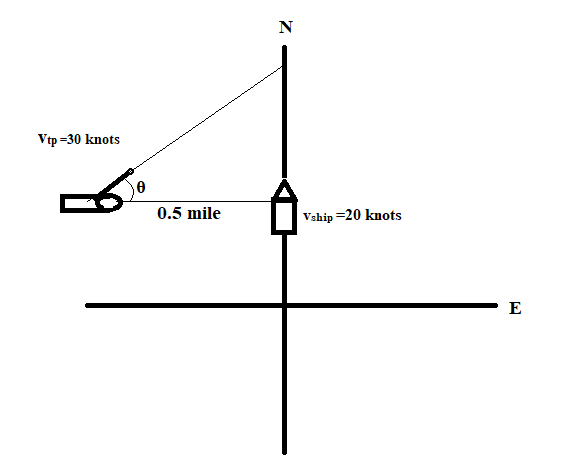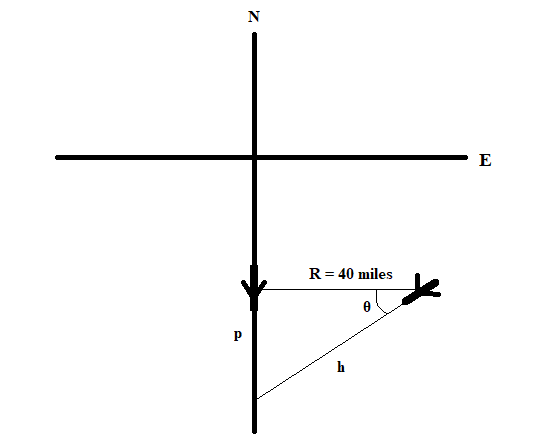
Concept explainers
Use the relative velocity equation and solve graphically or analytically.
a. A ship is steaming due north at 20 knots (nautical miles per hour). A submarine is laying in wait 1/2 mile due west of the ship. The sub tires a torpedo on a course of 85 degrees. The torpedo travels at a constant speed of 30 knots. Will ii strike the ship! If not, by how many nautical miles will it miss?
b. A plane is flying due south at 500 mph at 35.000 ft altitude, straight and level. A second plane is initially 40 miles due east of the first plane, also at 35.000 feet altitude, flying straight and level and traveling at 550 mph. Determine the compass angle at which the second plane would be on a collision course with the first. How long will it take for the second plane to catch the first?
(a)
Whether the torpedo will strike the ship or not and by what distance will it miss the ship.
Answer to Problem 6.1P
The torpedo will miss the ship by 1.91 miles.
Explanation of Solution
Given:
Speed of ship
Speed of torpedo
Course of firing
Separation between ship and submarine(R) = 0.5 mile
Concept Used:
Calculation:
Drawing diagram,

From the above figure,
Now put
It is also calculated that,
Let, time to cover 5.74 miles by torpedo is,
In this duration, the distance travelled by ship is given by,
As the torpedo missed the target. Let it miss the target by a distance s, then,
Therefore, torpedo misses the target by 1.92 miles.
(b)
The compass angle at which the second plane would be on a collision course with the first and the time taken by the second plane to catch the first plane.
Answer to Problem 6.1P
The compass angle at which the second plane would be on a collision course with the first is
Explanation of Solution
Given:
Speed of first plane,
Speed of second plane,
Distance of separation between the planes,
Concept Used:
Calculation:
Drawing diagram,

From the diagram,
To collide head on, the two plane must cover the distances P and h in same time interval. Let it takes time t to cover these distances, then
Further simplify,
Therefore, the compass angle at which the second plane would be on a collision course with the first is
Now, time taken, t is given as,
Therefore, the time taken by the second plane to catch the first plane is 0.176 h.
Want to see more full solutions like this?
- What is the equivalent root of the system of the figure using the displacement of the block as a generalized coordinatearrow_forwardUse resolve vector component method to solve the following exercise.arrow_forwardWrite trigonometric relations or circuit equations for the stepwise solution method. Obtain the velocity equations by taking the time derivatives of the position equations. Obtain the acceleration equations by taking the time derivatives of the velocity equations.arrow_forward
- The single axis robot arm given below moves parallel to the paper plane around the O point. a. Find the position, velocity and acceleration equations of the linear trajectory with parabolic parts that will bring this robot arm from -30 starting position to +30 end position in 3 seconds with zero start and end velocities. Take the acceleration times as 1 second. b. Using these equations, find the position velocity and acceleration of the robot arm at t = 2.5 seconds.arrow_forwardFind the velocity values for different values of l(Theta) from the equation below and draw the graph between them. Note:- Use only equation no.2 to find the velocity.arrow_forwarduse two other solving techniques or methods to solve the problem in relative motionarrow_forward
- Solve the following with diagramarrow_forwardUsing graphical method solve this problem: Suppose you first walk A in a direction of B west of north then C in a direction D south of west. You rest for 20 minutes and started to compute the distance you traveled. Take A, B, C and D found in the table below. (You may use scale such as 1cm = 2m in your drawing) C. What is the angle between AC ? D. What is the angle between your first walk A to the resultant R?arrow_forwardPlease use instantaneous center of rotation, or vector diagram to solve for the velocity of C.arrow_forward
- Answer using GRAPHICAL METHOD. Make a representation of the following vector quantities a. A velocity of 20m/s north b. A force of 2000 dynes 45° east of south c. An acceleration of 5m/s2 at 200° d. A displacement of 14m 100° from +x-axis e. A force of 250N at 60° clockwise +x-axisarrow_forwardUsing graphical method solve this problem: Suppose you first walk A in a direction of B west of north then C in a direction D south of west. You rest for 20 minutes and started to compute the distance you traveled. Take A, B, C and D found in the table below. (You may use scale such as 1cm = 2m in your drawing) A. Sketch the problem in a Cartesian plane. B. How far are you from your starting point, and what is the compass direction of a line connecting your starting point to your final position (resultant R)? C. What is the angle between AC ? D. What is the angle between your first walk A to the resultant R?arrow_forwardUsing graphical method solve this problem: Suppose you first walk A in a direction of B west of north then C in a direction D south of west. You rest for 20 minutes and started to compute the distance you traveled. Take A, B, C and D found in the table below. (You may use scale such as 1cm = 2m in your drawing) A. Sketch the problem in a Cartesian plane. B. How far are you from your starting point, and what is the compass direction of a line connecting your starting point to your final position (resultant R)?arrow_forward
 Elements Of ElectromagneticsMechanical EngineeringISBN:9780190698614Author:Sadiku, Matthew N. O.Publisher:Oxford University Press
Elements Of ElectromagneticsMechanical EngineeringISBN:9780190698614Author:Sadiku, Matthew N. O.Publisher:Oxford University Press Mechanics of Materials (10th Edition)Mechanical EngineeringISBN:9780134319650Author:Russell C. HibbelerPublisher:PEARSON
Mechanics of Materials (10th Edition)Mechanical EngineeringISBN:9780134319650Author:Russell C. HibbelerPublisher:PEARSON Thermodynamics: An Engineering ApproachMechanical EngineeringISBN:9781259822674Author:Yunus A. Cengel Dr., Michael A. BolesPublisher:McGraw-Hill Education
Thermodynamics: An Engineering ApproachMechanical EngineeringISBN:9781259822674Author:Yunus A. Cengel Dr., Michael A. BolesPublisher:McGraw-Hill Education Control Systems EngineeringMechanical EngineeringISBN:9781118170519Author:Norman S. NisePublisher:WILEY
Control Systems EngineeringMechanical EngineeringISBN:9781118170519Author:Norman S. NisePublisher:WILEY Mechanics of Materials (MindTap Course List)Mechanical EngineeringISBN:9781337093347Author:Barry J. Goodno, James M. GerePublisher:Cengage Learning
Mechanics of Materials (MindTap Course List)Mechanical EngineeringISBN:9781337093347Author:Barry J. Goodno, James M. GerePublisher:Cengage Learning Engineering Mechanics: StaticsMechanical EngineeringISBN:9781118807330Author:James L. Meriam, L. G. Kraige, J. N. BoltonPublisher:WILEY
Engineering Mechanics: StaticsMechanical EngineeringISBN:9781118807330Author:James L. Meriam, L. G. Kraige, J. N. BoltonPublisher:WILEY





